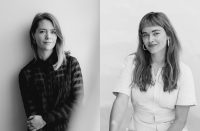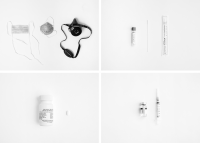
Kate Disher-Quill & Phoebe Powell
Q&A with Kate Disher-Quill & Phoebe Powell
6.1.21
We checked in with Melbourne-based artists Kate Disher-Quill & Phoebe Powell to find out how they went about creating a groundbreaking work about COVID-19 healthcare workers in the midst of the pandemic. The resulting project—Surge—is presented at PHOTO 2021 in partnership with the Metro Tunnel Creative Program.
Hello Kate and Phoebe, please start by telling us something about yourself that is not in your bio.
The two of us met back in 2016 when Phoebe photographed Kate’s Right Hear, Right Now exhibition—and we’ve been friends ever since! We live on opposite sides of Melbourne which made it a little challenging to physically work together during lockdown, however working collaboratively online kept us connected as we’d check in most days to discuss ideas and progress. It felt significant given that it was photography that initially connected us and photography which has kept us close this year during a time of isolation.
What will you be exhibiting at PHOTO 2021?
We will be exhibiting Surge, a series which evolved over the months of lockdown restrictions and which reflects the nuanced and at times confronting experiences encountered by a diverse range of healthcare professionals during the COVID-19 pandemic.
![Kate Disher-Quill & Phoebe Powell, David, from the series Surge, 2020 Image: Kate Disher-Quill & Phoebe Powell, [David], from the series Surge, 2020](https://photo.org.au/api/wp-content/uploads/2021/01/David_KateDisherQuillPhoebePowell-143x200.jpg)
Image: Kate Disher-Quill & Phoebe Powell, David, from the series Surge, 2020
What inspired this project?
Back in May 2020, Phoebe was commissioned by the Metro Tunnel Creative Program to create a Thank You portrait series of 52 healthcare workers after the first COVID-19 wave. With Kate assisting, the portrait sessions seemed to provide each participant with a little respite from what was a very stressful time at work. Listening to their insights and honest reflections, we realised that there was a much greater story that needed to be shared. Society is quick to acknowledge the professional achievements of healthcare workers, but in doing so we often overlook their personal experiences. We place an expectation on healthcare workers to ‘do their job’ and when asking a healthcare worker why they do what they do, the response is often ‘a sense of duty’. We felt it necessary to question that this expectation society places on healthcare workers might not equate to an individual being able to balance or prioritise their own health and wellbeing. For this reason, we wanted to show the broad scope of experiences—from scientific achievements and clinical protocols, through to personal challenges and the vulnerability of the human condition. The story and project itself unfolded and evolved along with the pandemic, as we didn’t realise at the time where the year would lead us.
How does it relate to the theme for PHOTO 2021: ‘The Truth’?
Like most historic events, politics and the media played a huge role in how various aspects of the pandemic were perceived by the public. However, behind each contentious headline and political debate was a human experience—a person analysing data in their home office, a nurse sitting with isolated patients unable to see family or friends, a doctor advocating for effective PPE, and the hundreds of thousands of healthcare workers showing up day after day, riddled with anxiety and fatigue. Their experiences—their ‘truth’—is what we wanted to acknowledge.

Image: Kate Disher-Quill & Phoebe Powell, Pandemic Paraphernalia, from the series Surge, 2020
Can you tell us about the process of making this work?
Due to the ongoing restrictions that unfolded throughout 2020, the process of making this work, while challenging, became a means for us to push ourselves creatively and explore new ways of working. For months we were unable to photograph anyone outside our homes, and so we initially took to Zoom to conduct candid interviews with the participants. While these conversations became central to developing the project, further to that they became a significant place of connection and catharsis. For us—the artists stuck at home—we thrived on the first hand insight from the participants worlds. And for the participants, we offered a unique space to share their stories and reflect on their experiences—from their fears and fatigue, through to their moments of joy and hopes for the future.
Unable to physically see their world through our own eyes (and cameras), a collaborative process evolved in which the participants shared their own images with us. At home, we constructed recreations of their stories and images, placing ourselves and our partners in front of the camera, and in turn putting ourselves into the participants’ experiences. This process not only gave us the opportunity to experiment, but gave us a deeper understanding of their stories and served as an escape from the repetitive and isolating nature of lockdown. Once the lockdown restrictions were lifted, we were able to engage with the participants directly, creating their portraits which reflected the experiences they had shared with us.
Throughout the process we merged our two different photographic styles of documentary storytelling with commercial studio photography—the resulting work was a collaboration between two artists and 12 participants. While the restrictions and limitations initially caused frustration, this slow, reflective and collaborative process essentially became our most valuable asset.
What do you hope audiences take from your work?
We decided that the work should in some way reflect the journey of the pandemic, so the series starts at the beginning with the virus and ends with a feeling of solace and relief. What people have experienced this year is beyond what many of us could ever have imagined, and we felt that it was necessary to acknowledge the diversity of responses (excitement, exhaustion, frustration, joy, pain, hope). While the experiences reflected in the work are those of healthcare workers, they were not experienced by healthcare workers alone. Thus, we see this work as a collective experience, a collective journey. And in order for us to process the year and all that we have endured, we want this work to act as a tool which can help us reflect and ultimately, recover.
![Image: Kate Disher-Quill & Phoebe Powell, [Marked], from the series Surge, 2020.](https://photo.org.au/api/wp-content/uploads/2020/10/7_Marked_KateDisherQuillPhoebePowell-200x99.jpg)
Image: Kate Disher-Quill & Phoebe Powell, Marked, from the series Surge, 2020.
If your work at PHOTO 2021 was a song, what would it be?
Present Tense by Radiohead. The song is a kind of meditative journey—filled with darkness, light, chaos, endurance and release.
Which other artists or exhibitions are you looking forward to seeing at PHOTO 2021?
Ahh so many! Amos Gebhardt, Atong Atem, Hoda Afshar, Hayley Millar-Baker, Lillian O’Neil to name a few…
And finally, what advice would you give to your 15 year old self?
Kate: Listen to your parents.
Phoebe: Wash your hands.
Don’t miss Kate Disher-Quill & Phoebe Powell’s project Surge at PHOTO 2021.
![Kate Disher-Quill & Phoebe Powell, Tied, from the series Surge, 2020 Image: Kate Disher-Quill & Phoebe Powell, [Tied], from the series Surge, 2020](https://photo.org.au/api/wp-content/uploads/2021/01/Tied_KateDisherQuillPhoebePowell-200x98.png)
Image: Kate Disher-Quill & Phoebe Powell, Tied, from the series Surge, 2020